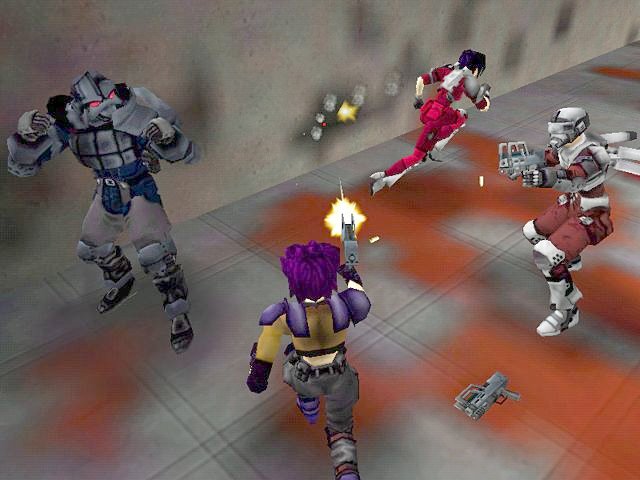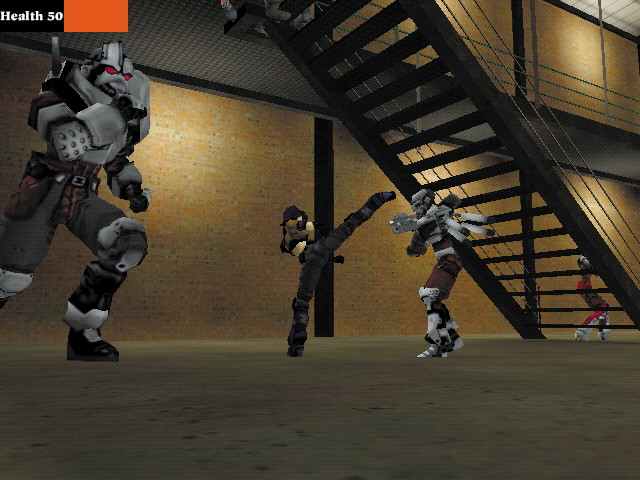Pre-beta features: Difference between revisions
m (link fixes) |
(top-to-bottom copy-edit; streamlined wording, moved big block of text to bottom of page to get it out of the way of the pictures, floated the TOC, placed all commentary consistently below images) |
||
| Line 1: | Line 1: | ||
:''This article is about | :''This article is about changes in the game engine during development. To learn about changes made to the levels and other game assets, see the [[Pre-beta content]] page.'' | ||
Below | Below we discuss features that were cut from Oni before release. Features that were teased in interviews are not listed if there is no evidence of them in visual or textual form. | ||
{{TOCfloat|side=right}} | |||
==Multiplayer== | ==Multiplayer== | ||
See the [[Multiplayer]] article to learn all about the most infamous missing feature from Oni. | |||
==Blood, shadows, and bullet marks== | ==Blood, shadows, and bullet marks== | ||
[[Image:Pre-beta_blood.jpg]] | [[Image:Pre-beta_blood.jpg]] | ||
These real-time stencil effects could build in intensity, as seen above where the burn effects are darker where Konoko continues to shoot the wall, as well as with the blood seen [[:Image:1999_Trailer_-_MP_arena_2-24.jpg|HERE]]. | |||
One can see the system in motion at [https://www.youtube.com/watch?v=rW4w_7GRUPE#t=0m53s 0:53] in the 1999 trailer where Konoko's shadow appears as she lands, and morphs along with her movements; as she shoots an enemy, small droplets of blood can be seen spraying onto the floor. Another shot with real-time shadowing is found at [https://www.youtube.com/watch?v=rW4w_7GRUPE#t=1m14s 1:14]. | |||
The resolution of these dynamic shading effects was quite low, so possibly Bungie West was dissatisfied with its appearance. The system also seemed to have trouble crossing polygon boundaries, as seen on the floors in <u>[[:Image:Genesis_Level3_12.jpg|these]]</u> <u>[[:Image:Genesis_Level3_5.jpg|two]]</u> screenshots and elsewhere. By the [[wp:E3|E3]] of May 2000, blood had been removed from publicly demoed builds. Matt Soell [http://carnage.bungie.org/oniforum/oni.forum.pl?read=3519 said that] this was in order to re-work the effect: "Along with the marks left by bullets, blood will look much better than it used to." Bungie eventually settled for a generic round texture for character shadows and various stencil textures for the weapons' impact effects. The blood effect was totally removed. | |||
[http://carnage.bungie.org/oniforum/oni.forum.pl?read=6559 The explanation] for the cutting of blood was not technical limitations, but rather that it interfered with the hit flashes that players needed as cues in a melee fight, and also to avoid a Mature rating from the [[wp:Entertainment Software Rating Board|ESRB]] (and the equivalent bodies outside North America). Animated blood would have gotten Oni an "M" rating and limited the number of younger players who were allowed to buy or play the game. This was the first time that Bungie shied away from putting blood in their games, and the Marathon and Myth games had received "M" ratings, so this was a controversial decision among some fans. It's possible that Oni's new owners, Take-Two Interactive, had a different philosophy on realistic violence vs. marketability. | |||
==Lightmapping== | ==Lightmapping== | ||
[[Image:ManPlant14.jpg]] | |||
[[ | Oni was originally intended to have detailed lighting produced through radiosity, as mentioned in Oni's [[Oni/Positioning|positioning statement]]. An outside program would be used to pre-calculate detailed lighting solutions which Bungie West would then export as lightmap textures. These textures would be displayed on surfaces in-game via [[OpenGL]] multitexturing. The smoothly-shaded spotlights you see on these walls could not be accomplished through the engine's current vertex-coloring approach to shading (not without subdividing the walls into a ridiculous number of vertices). | ||
---- | |||
{| | {| | ||
!1999 | !1999 | ||
| Line 33: | Line 28: | ||
|[[Image:ManPlant11.jpg|320px]] | |[[Image:ManPlant11.jpg|320px]] | ||
|[[Image:Ch. 2 dynamo room.jpg|320px]] | |[[Image:Ch. 2 dynamo room.jpg|320px]] | ||
|- | |||
|colspan=2 align=center|(click images to enlarge) | |||
|} | |} | ||
Here's a before/after from Musashi Manufacturing. In the original version of this area, the lights actually do something. The light and shadow give a greater sense of volume to the space. | |||
---- | |||
{| | {| | ||
|- | |- | ||
|[[Image:ManPlant4.jpg|320px]] | |[[Image:ManPlant4.jpg|320px]] | ||
|[[Image:ManPlant3.jpg|320px]] | |[[Image:ManPlant3.jpg|320px]] | ||
|- | |||
|colspan=2 align=center|(click images to enlarge) | |||
|} | |} | ||
It may be hard to believe that this imagery came from Oni's engine, but the jaggies on | These are a couple tests that were probably rendered in-game. It may be hard to believe that this imagery came from Oni's engine, but the [[wp:Jaggies|jaggies]] on the polygons mean that it is unlikely to be a product of the 3D Studio Max renderer like [[:Image:TCTF0.jpg|this anti-aliased rendering]], and if one looks closely, blockiness is evident in some shadows due to the limited resolution of lightmaps. Up close this would be much more noticeable, as in [[:Image:ManPlant2.jpg|this image]] (note the shadow on the pipe leading down to the tank). | ||
---- | |||
{| | {| | ||
!1999 | !1999 | ||
| Line 54: | Line 52: | ||
|[[Image:Ch. 2 lobby before.jpg]] | |[[Image:Ch. 2 lobby before.jpg]] | ||
|[[Image:Ch. 2 lobby after.jpg|320px]] | |[[Image:Ch. 2 lobby after.jpg|320px]] | ||
|- | |||
|colspan=2 align=center|(click images to enlarge) | |||
|} | |} | ||
The wall in the lobby down to Konoko's right used to have illumination from two point lights on the wall, as well as | Perhaps one of the most striking before/after shots illustrating the effect that lightmapping could have had on the game is found in the Musashi lobby. The wall in the lobby area down to Konoko's right used to have illumination from two point lights on the wall, as well as dappled light filtering through the glass windows at the entrance. Now we simply have rectangles for light fixtures, with lens flare sprites slapped on top of them, and no light falling on the wall. Even the vertex coloring that replaced lightmapping in retail Oni doesn't seem to be used to the fullest extent possible. | ||
==Rigid body physics== | ==Rigid body physics== | ||
[[wp:Rigid body dynamics|Rigid body physics | [[wp:Rigid body dynamics|Rigid body physics]], more often referred to by fans using simpler terms such as "kickable chairs" or "movable furniture", [[Oni/Positioning|were promised]] for much of Oni's development, but all furniture in the game is now static. Modders have uncovered the fact that there is code present in Oni for movable objects, but the collision is unpolished. Watch Konoko play with [https://www.youtube.com/watch?v=LUmmLTjSaqQ spheres] and [https://www.youtube.com/watch?v=Te9yKA4UR18 cubes]. You'll notice that all movable objects are treated as spheres by the collision code. | ||
==Inverse kinematics== | ==Inverse kinematics== | ||
[[wp:Inverse kinematics| | [[wp:Inverse kinematics|Inverse kinematics]], also promised in Oni's [[Oni/Positioning|positioning statement]], was planned in order to allow complex melee interactions such as disarm moves. IK was removed when Bungie West found a simpler solution, as explained by Bungie spokesman Matt Soell [http://carnage.bungie.org/oniforum/oni.forum.pl?read=4166 here]. | ||
==Rationale for cuts== | |||
When contemplating why various graphical effects below were removed, it's important to keep in mind that VRAM on graphics cards often ranged from 16-32MB at the time of Oni's release, and the game was likely developed with that range as a target. As [[Alex Okita]] [https://web.archive.org/web/20170705124855/http://www.glixel.com/interviews/oni-bungies-classic-inspired-by-ghost-in-the-shell-w474297 later recalled], "we had one thing in mind when we were going into it, thinking that video cards would catch up. But then halfway through, Apple hands us this iMac, and our bar just sort of dropped on top of us. We're trying to figure out how we're going to get anything to run on it. They had this, I don't know – [[wp:IMac_G3#2nd_generation:_Slot-loading|eight-megabyte video card]] or something? It was pretty miserable." | |||
An anecdotal report [http://carnage.bungie.org/oniforum/oni.forum.pl?read=1612 here] from a forum member indicates that Bungie may have had frame rate troubles as well. Even watching the [[1999|1999 trailer]], one can see segments which seem to be running as low as 10 frames per second. | |||
[[Category:Oni history]] | [[Category:Oni history]] | ||
Revision as of 15:28, 16 March 2022
- This article is about changes in the game engine during development. To learn about changes made to the levels and other game assets, see the Pre-beta content page.
Below we discuss features that were cut from Oni before release. Features that were teased in interviews are not listed if there is no evidence of them in visual or textual form.
Multiplayer
See the Multiplayer article to learn all about the most infamous missing feature from Oni.
Blood, shadows, and bullet marks
These real-time stencil effects could build in intensity, as seen above where the burn effects are darker where Konoko continues to shoot the wall, as well as with the blood seen HERE.
One can see the system in motion at 0:53 in the 1999 trailer where Konoko's shadow appears as she lands, and morphs along with her movements; as she shoots an enemy, small droplets of blood can be seen spraying onto the floor. Another shot with real-time shadowing is found at 1:14.
The resolution of these dynamic shading effects was quite low, so possibly Bungie West was dissatisfied with its appearance. The system also seemed to have trouble crossing polygon boundaries, as seen on the floors in these two screenshots and elsewhere. By the E3 of May 2000, blood had been removed from publicly demoed builds. Matt Soell said that this was in order to re-work the effect: "Along with the marks left by bullets, blood will look much better than it used to." Bungie eventually settled for a generic round texture for character shadows and various stencil textures for the weapons' impact effects. The blood effect was totally removed.
The explanation for the cutting of blood was not technical limitations, but rather that it interfered with the hit flashes that players needed as cues in a melee fight, and also to avoid a Mature rating from the ESRB (and the equivalent bodies outside North America). Animated blood would have gotten Oni an "M" rating and limited the number of younger players who were allowed to buy or play the game. This was the first time that Bungie shied away from putting blood in their games, and the Marathon and Myth games had received "M" ratings, so this was a controversial decision among some fans. It's possible that Oni's new owners, Take-Two Interactive, had a different philosophy on realistic violence vs. marketability.
Lightmapping
Oni was originally intended to have detailed lighting produced through radiosity, as mentioned in Oni's positioning statement. An outside program would be used to pre-calculate detailed lighting solutions which Bungie West would then export as lightmap textures. These textures would be displayed on surfaces in-game via OpenGL multitexturing. The smoothly-shaded spotlights you see on these walls could not be accomplished through the engine's current vertex-coloring approach to shading (not without subdividing the walls into a ridiculous number of vertices).
| 1999 | 2001 |
|---|---|
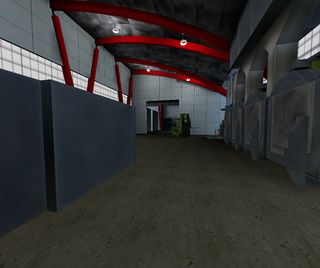
|
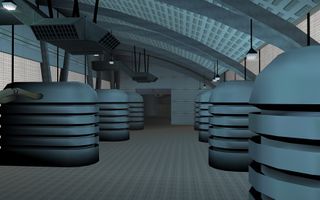
|
| (click images to enlarge) | |
Here's a before/after from Musashi Manufacturing. In the original version of this area, the lights actually do something. The light and shadow give a greater sense of volume to the space.
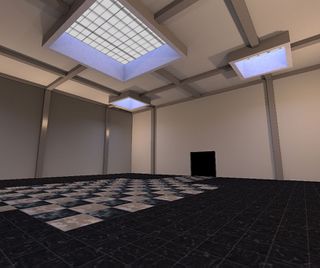
|
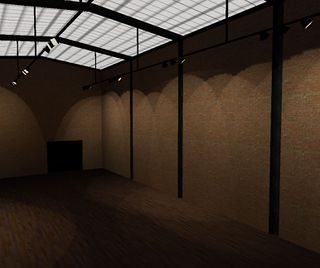
|
| (click images to enlarge) | |
These are a couple tests that were probably rendered in-game. It may be hard to believe that this imagery came from Oni's engine, but the jaggies on the polygons mean that it is unlikely to be a product of the 3D Studio Max renderer like this anti-aliased rendering, and if one looks closely, blockiness is evident in some shadows due to the limited resolution of lightmaps. Up close this would be much more noticeable, as in this image (note the shadow on the pipe leading down to the tank).
| 1999 | 2001 |
|---|---|
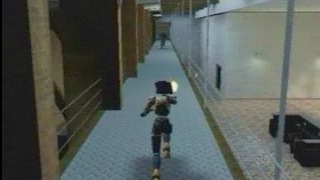
|
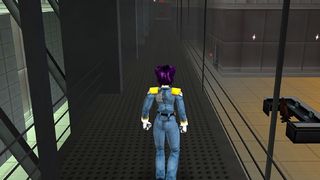
|
| (click images to enlarge) | |
Perhaps one of the most striking before/after shots illustrating the effect that lightmapping could have had on the game is found in the Musashi lobby. The wall in the lobby area down to Konoko's right used to have illumination from two point lights on the wall, as well as dappled light filtering through the glass windows at the entrance. Now we simply have rectangles for light fixtures, with lens flare sprites slapped on top of them, and no light falling on the wall. Even the vertex coloring that replaced lightmapping in retail Oni doesn't seem to be used to the fullest extent possible.
Rigid body physics
Rigid body physics, more often referred to by fans using simpler terms such as "kickable chairs" or "movable furniture", were promised for much of Oni's development, but all furniture in the game is now static. Modders have uncovered the fact that there is code present in Oni for movable objects, but the collision is unpolished. Watch Konoko play with spheres and cubes. You'll notice that all movable objects are treated as spheres by the collision code.
Inverse kinematics
Inverse kinematics, also promised in Oni's positioning statement, was planned in order to allow complex melee interactions such as disarm moves. IK was removed when Bungie West found a simpler solution, as explained by Bungie spokesman Matt Soell here.
Rationale for cuts
When contemplating why various graphical effects below were removed, it's important to keep in mind that VRAM on graphics cards often ranged from 16-32MB at the time of Oni's release, and the game was likely developed with that range as a target. As Alex Okita later recalled, "we had one thing in mind when we were going into it, thinking that video cards would catch up. But then halfway through, Apple hands us this iMac, and our bar just sort of dropped on top of us. We're trying to figure out how we're going to get anything to run on it. They had this, I don't know – eight-megabyte video card or something? It was pretty miserable."
An anecdotal report here from a forum member indicates that Bungie may have had frame rate troubles as well. Even watching the 1999 trailer, one can see segments which seem to be running as low as 10 frames per second.
